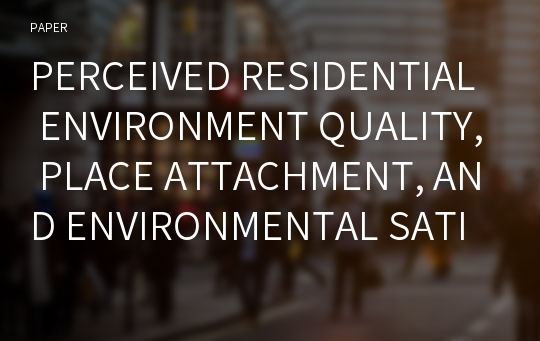PERCEIVED RESIDENTIAL ENVIRONMENT QUALITY, PLACE ATTACHMENT, AND ENVIRONMENTAL SATISFACTION: THE COMPETING MODELS IN RURAL AND URBAN AREAS OF CHINA
* 본 문서는 배포용으로 복사 및 편집이 불가합니다.
서지정보
ㆍ발행기관 : 글로벌지식마케팅경영학회(GFMC)
ㆍ수록지정보 : Global Marketing Conference
ㆍ저자명 : Kangkang Yu, Ning (Chris) Chen, Xinkai Zhu, Jian Gao
ㆍ저자명 : Kangkang Yu, Ning (Chris) Chen, Xinkai Zhu, Jian Gao
영어 초록
Level of urbanization in China has reached 53.73% in 2013, indicating a tremendous progress on the urbanization of China. On the other hand, the number of villages in China reduces by around one million from 3.6 million in 2000 to 2.7 million in 2010 (Zhang, 2014). Issues in both urban and rural areas of China appear, including the imbalance between increased population and limited resources in urban region, and more significantly, the increasing disparity between rural and urban areas. Chinese researchers interpret and analyse these matters from different perspectives. For instance, Zheng (2006) and Ma (2006) suggest the importance of the infrastructure construction and public service. Wu (2006) advises that the government should pay attention to the development of the secondary and tertiary industry. Wen (2005) proposes that the improvement of social institution and the recovery of social cultural environment are required to achieve sustainability in the urbanization process in China. Previous studies in environmental psychology put quality of life, attachment to place, and residence satisfaction at the center to understand the relationship between inhabitants and their neighborhood of residence. However, there are gaps in this research realm in both practice and theories. Firstly, very limited research studies this environmental psychology issue in China (e.g. Mao, Fornara, Manca, Bonnes, & Bonaiuto, 2015). Secondly, there are different opinions on the causal order between quality, attachment, and satisfaction.Research on the relationship between perceived residential environment quality (PREQ), place attachment, and environmental satisfaction has not reached a consensus. The debate on the direction of the causal relationship between perceived quality and satisfaction has been summarized by Bradya and Robertson (2001). They conclude that the quality to satisfaction causal order holds up well across diverse cultures. However, relevant debate is still ongoing. A number of research articles place satisfaction as an antecedent to attachment, e.g. Chen, Dwyer, and Firth (2014); Lee, Kyle, and Scott (2012); Ramkissoon and Mavondo (2015); etc. Some argue that place attachment is an indicator of satisfaction. Kyle et al. (2004) investigate the effect of place attachment on the perceived values of tourists and find that place attachment is an important factor explaining the variance of perceived values. This is supported by research e.g. Hwang, Lee, and Chen (2005); Prayag and Ryan (2012); Yuksel, Yuksel, Biljm (2010); etc.
As to the relationship between perceived quality and attachment, the debate has not stopped. Through comparisons, Mesch and Manor (1996) conclude that the residents who give a higher evaluation of the social and natural environment may have greater place attachment. Brown, Perkins, and Brown (2003) also suggest that the residents who agree that the street environment is better would attach to this place. Sam, Bayram, and Bilgel (2012) have certified the relationship between residential environment quality and place attachment. Furthermore, Borrie and Roggenbuck (2001) and Walker and Ryan (2008) find that the connection between human beings and the nature environment would affect their affection toward the environment. It means that the closer the relationship with the nature environment is, the stronger the attachment would be, which in turn, enhances the intentions to protect the environment. This quality to satisfaction relationship is supported by other research such as Bonaiuto, Aiello, Perugini, Bonnes, and Ercolani (1999); Grisaffe and Nguyen (2011); Yu, Chen, and Chen (2015); etc. Nevertheless, a different opinion arguing that attachment to a place may affect one’s perception on the quality related to a place is emerging in tourism research (e.g. Neuvonen, Pouta, & Sievänen, 2010).
This paper takes the credit of quality → attachment → satisfaction causal order as the initial model and proposes three hypotheses as follows. H1a: One’s PREQ has a positive impact on his/her attachment to this place; H2a: One’s attachment to a place has a positive impact on his/her satisfaction to the environmental settings in this place; H3a: Place attachment in addition performs as a mediating role between PREQ and environment satisfaction.To be noted, the initial model has its theoretical basis as discussed above but is not necessarily the absolute optimal model. Relatively, this model provides more theoretical interpretation and practical implications in the specific research context: residential psychology in urban and rural areas of China. On this basis, this article further examines a competing model illustrating an alternative theoretical framework on the relationships between these three constructs (satisfaction → attachment → quality). Relatively, another group of hypotheses in this competing model is listed as follows. H1b: One’s attachment to a place has a positive impact on his/her PREQ; H2b: One’s satisfaction to the environmental settings in this place has a positive impact on his/her attachment to this place; H3b: Place attachment in addition performs as a mediating role between environment satisfaction and PREQ.
A survey approach is employed and data are collected from several backgrounds. Dataset A (rural) is collected from three villages from Heilongjiang Province and two villages from Shandong Province in China from July to August 2014. The choices of the provinces, rural areas, and the sampling process are random. 490 valid questionnaires are included in the data analysis. Dataset B (urban) is collected via an online survey portal, which allows a nationwide sampling reach. In total 1368 online survey entries are recorded and 420 valid questionnaires are included, resulting in a valid rate of 30.7%. The measures for each construct are based on an extensive literature review. The measurement of perceived residential environment quality is from Sam, Bayram, & Bilgel’s (2012) development on the perception of residential environment. The measurement of place attachment in this study is adopted from Kyle, Graefe, and Manning’s (2005) and Chen, Dwyer, and Firth’s (2014) evaluation based place attachment dimensionality and scales. As for the scale of environmental satisfaction, Pelletier, Legault, and Tuson’s (1996) measure was applied. All the entire variables adopted multiple-item, 5-point Likert scales were adopted, where “1” indicated “strongly disagree” and “5” indicated “strongly agree”. After pre-testing the preliminary version of the survey instrument, a revised version was developed.
This study adopts structural equation modeling (SEM) based on partial least squares (PLS) modeling given the small sample size and the explorative purpose of this study (Dijkstra & Henseler, 2015a). The software used was Smart PLS 3.0. The reliability and validity of the constructs were assessed. Cronbach’s alpha and the value of CR of each construct were found to exceed the cut-off value of 0.70 (Fornell & Larcker, 1981), except for adequacy of education which is close to 0.70 (only for Cronbach’s alpha but not for CR). Furthermore, the AVE of each construct exceeded the variance attributable to its measurement error cut-off value of 0.50 (Chin, 1998; Fornell & Larcker, 1981). In addition, heterotrait-monotrait ratio (HTMT) is recommended as a better method to test discriminant validity (Henseler, Dijkstra, Sarstedt, Ringle, Diamantopoulos, Straub, Ketchen, Hair, Hult, & Calantone, 2014). The result shows that there is neither value of the HTMT higher than the threshold of 0.85 nor confidence interval containing the value one, indicating that all the constructs exhibit satisfactory discriminant validity.
The hypothesized effects in the theoretical model were tested by structural equation modeling (SEM). The first group of models tested the effect of perceived environmental quality on environmental satisfaction through place attachment i.e. initial model (Model A, Model B, Model C), while the second group of models tested the reverse effect of environmental satisfaction on perceived environmental quality through place attachment (Model D, Model E, Model F). Both the full model and the multi-group model were tested. The value of SRMR of the full model that tests either the effect of perceived environmental quality on environmental satisfaction (SRMR = 0.104, t = 41.826, p < 0.001) or the reversed effect (SRMR = 0.106, t = 37.736, p < 0.001) shows that the models fit the data quite well (Dijkstra & Henseler, 2015b). However, the former is little bit more significant.
In this study, PREQI is found different impacts on place attachment and environmental satisfaction. This provides evidence to support a similar mechanism of studying residents’ psychology with SERVEQUAL model. However, the model testing is found significantly different between rural and urban samples, indicating a systematic difference in the psychology of rural and urban populations. Quality attachment satisfaction causal order is found significant and supported by both samples in this study. However, a reversed causal order model (satisfaction attachment quality) is also supported by the samples. Although the results may not be able to end the debate on alternative models between PREQ, place attachment, and environmental satisfaction, this paper provides empirical evidence from a specific context (urban and rural China) for further research. Specifically, PREQ has a significant impact on place attachment in both urban and rural areas in China. As for the impact of place attachment on environmental satisfaction as well as the indirect impact of PREQ on environmental satisfaction, the influence is more significant in cities of China compared to rural areas. This suggests in the urban areas in China, affective and emotional responses to their lives play an important role to residents. Local government in cities should balance between improving and maintaining quality of the environment and strengthening local residents’ psychological attachment to the place. Governments in rural areas, on the other hand, should lay great focus on the physical aspects of the environment including nature, health, education, commerce, and venture of the rural areas, to enhance residents’ living experience and satisfaction.
Further, there are some limitations. Although this study attempts to clarify the framework of “perception-affection-attitude” in the field of environment management, considering the practical implications, the future study could bring the individuals’ behaviors or intentions into this model such as willingness-to-pay for environment-friendly products. It will also benefit from reviewing more literature on community-based social marketing.
참고 자료
없음태그
"Global Marketing Conference"의 다른 논문
 THE ROLES OF GREEN PACKAGING IN UGLY FOOD PURCHASE INTE..22페이지
THE ROLES OF GREEN PACKAGING IN UGLY FOOD PURCHASE INTE..22페이지 THE IMPACT OF INDUCED AWE ON ETHICAL TOURIST BEHAVIORS5페이지
THE IMPACT OF INDUCED AWE ON ETHICAL TOURIST BEHAVIORS5페이지 A BIBLIOMETRIC ANALYSIS OF SPIRITUAL TOURISM RESEARCH15페이지
A BIBLIOMETRIC ANALYSIS OF SPIRITUAL TOURISM RESEARCH15페이지 SOCIAL NETWORK ANALYSIS AND RESPONSE TIME TESTING: CONS..11페이지
SOCIAL NETWORK ANALYSIS AND RESPONSE TIME TESTING: CONS..11페이지 THE EFFECTS OF PARA-SOCIAL INTERACTION ON ONLINE CELEBR..3페이지
THE EFFECTS OF PARA-SOCIAL INTERACTION ON ONLINE CELEBR..3페이지 THE INFLUENCE OF OPINION LEADERS ON DAILY DEALS USER’S ..3페이지
THE INFLUENCE OF OPINION LEADERS ON DAILY DEALS USER’S ..3페이지 HOW IMMERSIVE RETAILING AFFECTS CONSUMERS’ URGE TO BUY:..6페이지
HOW IMMERSIVE RETAILING AFFECTS CONSUMERS’ URGE TO BUY:..6페이지 KEY TO SUPERSTARDOM IN A GLOBALISED MARKET: THE ROLE OF..6페이지
KEY TO SUPERSTARDOM IN A GLOBALISED MARKET: THE ROLE OF..6페이지 A POST-PANDEMIC LOOK AT TOURISTS’ PERCEIVED COOLNESS OF..4페이지
A POST-PANDEMIC LOOK AT TOURISTS’ PERCEIVED COOLNESS OF..4페이지 EXTRACTING OFFLINE RETAIL SHOPPING PATTERNS: OLLABORATI..5페이지
EXTRACTING OFFLINE RETAIL SHOPPING PATTERNS: OLLABORATI..5페이지

























